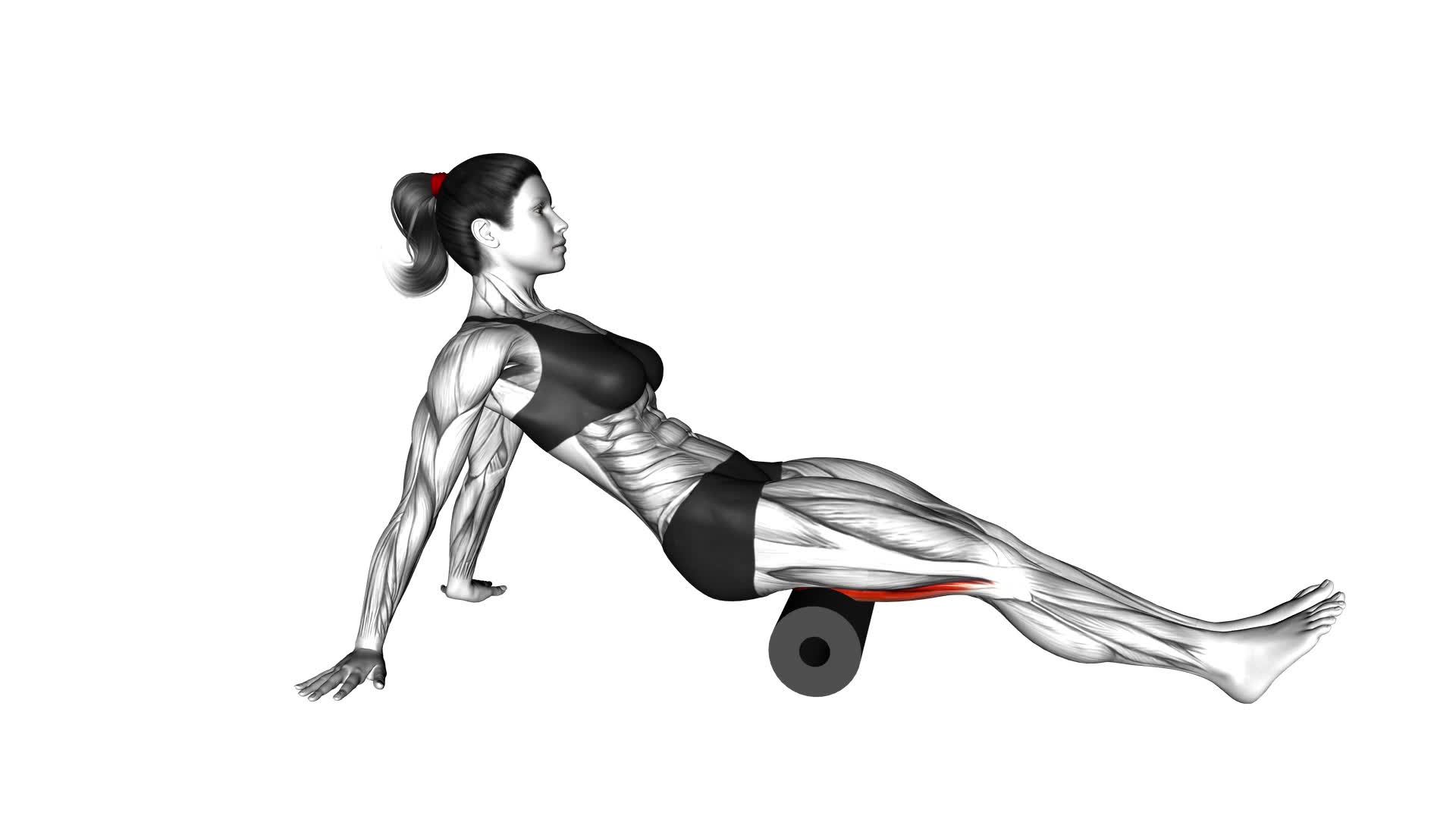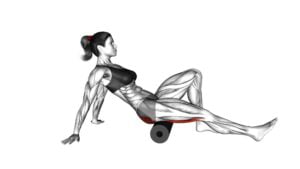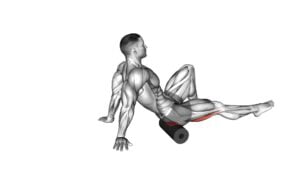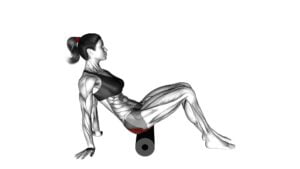Roll Hamstrings Sitting on Floor (female) – Video Exercise Guide & Tips

Are you looking for a quick and effective way to stretch your hamstrings? Look no further! In this video exercise guide, we'll show you how to roll your hamstrings while sitting on the floor.
Watch This Exercise Video
This exercise is specifically designed for females and is a great way to increase flexibility and improve muscle recovery. Follow along as we provide you with step-by-step instructions and valuable tips to ensure you get the most out of this exercise.
Let's get started!
Key Takeaways
- Rolling hamstrings on the floor improves hamstring flexibility and increases range of motion.
- It enhances performance in activities like running and jumping and reduces the risk of strains and pulls.
- Proper form techniques and stretching warm-up exercises are important for maximizing benefits and minimizing injury risk.
- Using the necessary equipment such as a foam roller or yoga mat ensures a safe and effective workout.
Benefits of Rolling Hamstrings on the Floor
You can experience several benefits by rolling your hamstrings on the floor.
Rolling your hamstrings helps to improve hamstring flexibility, which is essential for performing various activities and exercises. By regularly rolling your hamstrings, you can increase their flexibility, allowing for a greater range of motion and improved performance in activities such as running, jumping, and even sitting or standing for long periods.
In addition to improving flexibility, rolling your hamstrings can also help prevent injuries. Tight hamstrings are a common cause of injuries, such as strains and pulls, especially in athletes or individuals who engage in activities that require a lot of leg movement. By rolling your hamstrings, you can loosen up any tightness or tension in the muscles, reducing the risk of injury and improving overall muscle function.
Preparing for the Exercise
Before you begin rolling your hamstrings on the floor, it's important to focus on proper form techniques. This will ensure that you're targeting the correct muscles and minimizing the risk of injury.
Additionally, incorporating stretching warm-up exercises into your routine will help to prepare your hamstrings for the rolling motion.
Lastly, gather any necessary equipment, such as a foam roller or yoga mat, to provide support and stability during the exercise.
Proper Form Techniques
To properly prepare for the roll hamstrings sitting on the floor exercise, ensure that your body is positioned correctly. Here are three proper form techniques to keep in mind:
- Maintain a straight back: Sit up tall with your spine aligned and shoulders relaxed. Avoid slouching or rounding your back, as this can lead to poor form and potential injury.
- Extend your legs: Straighten your legs in front of you, keeping them parallel to each other. This position helps target the hamstrings effectively and prevents strain on other muscles.
- Engage your core: Activate your abdominal muscles by pulling your belly button in towards your spine. This helps stabilize your body and maintain proper posture throughout the exercise.
By following these proper form techniques, you can maximize the benefits of the roll hamstrings sitting on the floor exercise while minimizing the risk of injury.
Remember to always start with a stretching warm-up before performing any exercise to prepare your muscles for movement.
Stretching Warm-Up Exercises
To properly prepare for the exercise, incorporate stretching warm-up exercises into your routine. A warm-up routine is essential for any workout as it helps to increase blood flow to the muscles and prepares them for the upcoming activity. Stretching before exercise is particularly important for flexibility training, as it helps to improve your range of motion and prevent injuries.
Start with dynamic stretches, such as arm circles and leg swings, to loosen up the joints and increase mobility. Follow this with static stretches, holding each stretch for 15-30 seconds, focusing on the major muscle groups you'll be using during the exercise. By incorporating stretching warm-up exercises into your routine, you'll enhance your performance and reduce the risk of injury.
Now, let's move on to the equipment needed for safety.
Equipment Needed for Safety
To ensure your safety and minimize the risk of injury, gather the necessary equipment for the exercise. Here are three items you'll need to perform the roll hamstrings sitting on the floor safely:
- Yoga mat: Use a yoga mat to provide cushioning and support for your body during the exercise. This will help prevent discomfort and potential strain on your back and knees.
- Foam roller: A foam roller is essential for rolling out your hamstrings effectively. It helps to release tension and tightness in the muscles, promoting flexibility and reducing the risk of injury.
- Towel or blanket: Roll up a towel or blanket and place it under your knee for added support and comfort. This will help protect your knee joint and prevent any discomfort during the exercise.
By having these equipment items ready, you can ensure a safe and effective workout.
Now let's move on to the next section and learn about the proper technique for rolling your hamstrings.
Proper Technique for Rolling Hamstrings
How can you effectively roll your hamstrings while sitting on the floor? Rolling your hamstrings is a great way to improve hamstring mobility and relieve tightness. To properly roll your hamstrings, start by sitting on the floor with your legs extended in front of you. Place a foam roller or a massage ball under your hamstrings, just above your knees.
Next, use your arms to lift your hips off the floor and shift your weight onto the foam roller or massage ball. Slowly roll down towards your knees, applying pressure to the hamstrings. You can also rotate your legs slightly to target different areas of the hamstrings.
As you roll, pay attention to any areas of tension or discomfort. Spend extra time on these areas, applying more pressure if necessary. Remember to breathe deeply and relax as you roll.
To transition into the next section about common mistakes to avoid, it's important to note that proper technique is crucial when rolling your hamstrings. By following the correct form and avoiding mistakes, you can maximize the benefits of this exercise and prevent any potential injuries.
Common Mistakes to Avoid
When it comes to rolling your hamstrings sitting on the floor, there are a few common mistakes you need to avoid. Incorrect form can lead to potential dangers and injuries, so it's important to maintain proper technique.
Overstretching your hamstrings can also be risky, so be sure to listen to your body and avoid pushing yourself too far.
Finally, neglecting to warm up before rolling can increase the risk of muscle strains or pulls.
Incorrect Form Dangers
While performing the roll hamstrings exercise sitting on the floor, it's important to be aware of the incorrect form dangers that you should avoid. Incorrect form can lead to injuries and hinder your progress. Here are three common mistakes to watch out for and how to prevent them:
- Rounded back: Avoid rounding your back during the exercise as it puts excessive strain on your spine. Keep your back straight and engage your core to maintain stability.
- Overstretching: Be cautious not to overstretch your hamstrings by rolling too far. This can result in strains or pulls. Roll only until you feel a comfortable stretch, not pain.
- Lack of control: Maintain control throughout the movement and avoid using momentum. Jerky or uncontrolled movements can cause muscle imbalances and increase the risk of injury.
By paying attention to proper form and avoiding these mistakes, you can safely perform the roll hamstrings exercise and prevent injuries.
Stay mindful of your body and listen to its signals to ensure an effective and injury-free workout.
Overstretching Risks
Be cautious not to overstretch your hamstrings during the roll hamstrings exercise sitting on the floor to prevent strains or pulls. Overstretching can lead to muscle imbalances, decreased flexibility, and even injury. To prevent overstretching, it's important to listen to your body and avoid pushing yourself beyond your limits.
Start the exercise with a gentle roll, gradually increasing the intensity as your flexibility improves. If you feel any pain or discomfort, stop immediately and seek guidance from a qualified fitness professional.
Additionally, incorporating alternative exercises into your routine can help prevent overstretching. These may include hamstring stretches using a resistance band, seated forward folds, or standing hamstring curls.
Lack of Warm-Up
To avoid the common mistake of a lack of warm-up, ensure that you properly prepare your muscles before performing the roll hamstrings exercise sitting on the floor. Warm-up is of utmost importance as it helps to increase blood flow, loosen muscles, and prepare the body for physical activity. Neglecting this crucial step can lead to injuries and hinder your progress.
Here are three reasons why warm-up is essential for injury prevention:
- Increased flexibility: Warm-up exercises help to improve flexibility by increasing the elasticity of muscles and joints. This allows for a wider range of motion during the roll hamstrings exercise and reduces the risk of strain or sprain.
- Enhanced circulation: Engaging in a warm-up routine increases blood flow to the muscles, delivering oxygen and nutrients while removing waste products. This promotes optimal muscle function and reduces the likelihood of muscle cramps or tears.
- Mental preparation: Warm-up exercises also help to mentally prepare you for the upcoming workout. They help to focus your mind, increase concentration, and improve overall performance.
Variations and Modifications
How can you modify and vary the roll hamstrings exercise while sitting on the floor?
There are several variations and modifications you can try to make this exercise more challenging or suitable for your fitness level.
One way to modify the roll hamstrings exercise is by using a foam roller. Instead of sitting on the floor, you can sit on a foam roller and roll it back and forth under your hamstrings. This provides a deeper massage and stretches the muscles even more.
Another variation is to use a resistance band. Sit on the floor with your legs extended in front of you and loop a resistance band around the arches of your feet. Hold onto the ends of the band and slowly roll back, using the band to help you control the movement. This variation adds an extra challenge to the exercise by engaging your core and upper body muscles.
If you find it difficult to sit on the floor, you can also do the roll hamstrings exercise while seated on a chair. Simply sit on the edge of a chair with your feet flat on the floor and follow the same rolling motion with your hamstrings. This modification allows you to still benefit from the exercise while providing some support for your lower back and hips.
Remember to always listen to your body and adjust the exercise as needed. By modifying and varying the roll hamstrings exercise, you can customize it to suit your needs and continue challenging your muscles.
Tips for Maximizing the Effectiveness of the Exercise
To maximize the effectiveness of the roll hamstrings exercise, it's important to focus on proper form and maintain a controlled and slow rolling motion. Here are three tips to help you maximize your results and avoid injuries:
- Warm up: Before starting the exercise, it's essential to warm up your muscles. This will increase blood flow and flexibility, reducing the risk of strain or injury. Consider performing dynamic stretching exercises or light cardio activities to prepare your body for the roll hamstrings exercise.
- Engage your core: While performing the roll hamstrings exercise, remember to engage your core muscles. This will help stabilize your body and maintain proper alignment throughout the movement. By keeping your core activated, you'll maximize the effectiveness of the exercise and reduce the strain on your lower back.
- Listen to your body: Pay attention to any discomfort or pain during the exercise. If you feel any sharp or intense pain, stop immediately and consult a healthcare professional. It's crucial to listen to your body's signals and adjust the exercise accordingly to avoid injuries and promote safe and effective results.
Frequently Asked Questions
Can Rolling Hamstrings on the Floor Help Improve Flexibility in Other Areas of the Body?
Rolling your hamstrings on the floor can indeed help improve flexibility in other areas of your body. By targeting the hamstrings, you're stretching and lengthening the muscles, which can lead to an increased range of motion in other parts of your body.
This improved flexibility can also help with injury prevention, as it allows your body to move more freely and reduces the risk of strain or muscle imbalances.
Incorporating hamstring rolling into your routine can be a valuable addition for overall flexibility and injury prevention.
How Often Should I Perform the Rolling Hamstrings Exercise to See Significant Results?
To see significant results with the rolling hamstrings exercise, you need to consider the frequency of your workouts. The effectiveness of rolling hamstrings can vary depending on how often you perform the exercise.
It's recommended to incorporate this exercise into your routine at least 2-3 times per week. Consistency is key when it comes to improving flexibility and seeing noticeable changes in your body.
Are There Any Specific Stretches or Warm-Up Exercises I Should Do Before Rolling Hamstrings on the Floor?
Before you start rolling your hamstrings on the floor, it's important to warm up your muscles and do some stretching. Incorporating a warm-up routine and stretching exercises into your pre-workout routine can help prevent injuries and increase your flexibility.
Some examples of warm-up exercises include jogging in place, jumping jacks, or arm circles. These exercises increase blood flow to your muscles and prepare them for the upcoming workout.
As for stretching, focus on your hamstrings by doing standing hamstring stretches or seated forward bends. These stretches target the muscles you will be working during the rolling hamstrings exercise and help improve their flexibility.
Can Rolling Hamstrings on the Floor Help Alleviate Lower Back Pain?
Rolling your hamstrings on the floor is a great exercise for improving flexibility and can potentially help alleviate lower back pain.
By targeting the hamstring muscles, you can release tension and tightness that may contribute to discomfort in your lower back.
Rolling your hamstrings regularly can also improve blood circulation and promote overall flexibility in your legs.
Remember to consult with a healthcare professional if you have any specific concerns or conditions.
Is It Normal to Feel Discomfort or Soreness in the Hamstrings After Performing the Rolling Hamstrings Exercise?
Feeling discomfort or soreness in your hamstrings after doing the rolling hamstrings exercise is normal. It's a sign that your muscles are being stretched and worked.
To improve hamstring flexibility and avoid excessive discomfort, make sure to maintain proper form during the exercise. This includes sitting on the floor with your legs extended and rolling the foam roller along the back of your thighs.
Remember to listen to your body and stop if the pain becomes sharp or unbearable.
Conclusion
In conclusion, rolling the hamstrings on the floor is a beneficial exercise that can help improve flexibility, reduce tightness, and prevent injuries in the lower body.
By following the proper technique and avoiding common mistakes, you can maximize the effectiveness of this exercise.
Additionally, variations and modifications can be incorporated to cater to individual needs and abilities.
Remember to always prioritize proper form and listen to your body to achieve the best results.

Author
Years ago, the spark of my life’s passion ignited in my mind the moment I stepped into the local gym for the first time. The inaugural bead of perspiration, the initial endeavor, the very first surge of endorphins, and a sense of pride that washed over me post-workout marked the beginning of my deep-seated interest in strength sports, fitness, and sports nutrition. This very curiosity blossomed rapidly into a profound fascination, propelling me to earn a Master’s degree in Physical Education from the Academy of Physical Education in Krakow, followed by a Sports Manager diploma from the Jagiellonian University. My journey of growth led me to gain more specialized qualifications, such as being a certified personal trainer with a focus on sports dietetics, a lifeguard, and an instructor for wellness and corrective gymnastics. Theoretical knowledge paired seamlessly with practical experience, reinforcing my belief that the transformation of individuals under my guidance was also a reflection of my personal growth. This belief holds true even today. Each day, I strive to push the boundaries and explore new realms. These realms gently elevate me to greater heights. The unique combination of passion for my field and the continuous quest for growth fuels my drive to break new ground.







